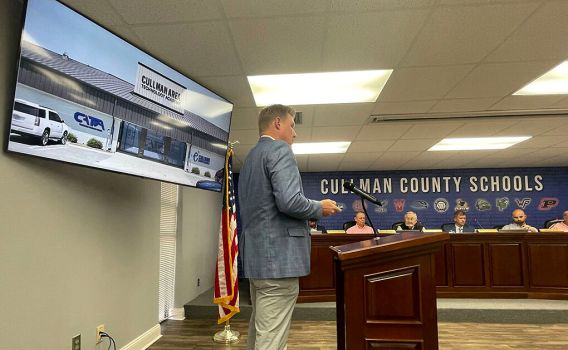CCBOE sees drop in utility costs after systemwide improvement projects
Published 6:19 pm Saturday, October 19, 2024
With the first phase of infrastructure upgrades at Cullman County School campuses complete, the Board of Education heard from Schneider Electric Thursday, Oct. 17, who provided an update on how the new system, installed by Schneider Electric, has been performing, how much it has cut down on school utility costs and what comes next.
“I was asked to come give an overview of what we’ve done with this first phase of our projects, what upgrades we’ve made and, most importantly, how we’re performing. I know that’s a big deal to make sure we are saving money,” Schneider Electric Sales Team Leader Todd Smith told the board during a work session Thursday.
The board first began discussions with Schneider in 2020 to develop a program for HVAC, lighting and mechanical upgrades across the district which would improve outdated infrastructure while also lower energy costs. The goal of the program was that, over time, these upgrades would be able to pay for themselves through energy savings.
Smith said the $14 million initial phase of the project had brought lighting upgrades to all buildings throughout the district along with several enhancements for added safety and security such as occupancy sensors and emergency egress fixtures. The district’s telecommunications system was also upgraded for all staff and administrative users which included emergency preparedness and backup features.
While not as noticeable to the casual spectator, the most intensive upgrades included a complete redesign and installation of new HVAC systems at the Fairview, Good Hope and Parkside campuses which have now been fully automated. Smith said five or six additional campuses have been identified as targets for an expansion of the automated system for phase 2 of the project.
“A lot of your schools had those really complicated water-source heat pump systems with boilers. There’s only so much you can do to squeeze efficiency out of those,” Smith said.
Schneider estimated these upgrades have reduced the district’s combined utility costs by nearly $390,000 as of July. Smith said he believed those saving were likely to currently be closer to $450,000 or $500,000.
Apart from the additional buildings to receive automated systems, Smith said phase 2 of the project will also include a complete mechanical redesign of Cold Springs High School. The current proposal showed the campuses heat sources being replaced with new split system heat pumps for the gym, office and weight room areas. Smaller locations such as classrooms, the library and locker rooms will receive mini-split systems and existing outdoor air units will also be replaced.
The highlight of the presentation was what Smith described as an “investment and refresh,” which would renovate the front exterior and main lobby of the Cullman Area Technology Academy.
“I have to tell you, our team was just amazed when we went and walked through the CATA facility,” Smith said. “I’ve been through so many career tech schools in Alabama and the programs you guys are offering are just fantastic. But, I think we can all admit that when you first pull to the school, it doesn’t really reflect the great things that are going on.”
Smith proposed adding new, updated signage to the front-facing exterior of the school along with tunable LED accent lighting which could be visible from the highway. A rendering also highlighted the installation of a 22-foot solar panel “tree” near the campus’ front lawn which he said would also feature LED lighting and seating which could be utilized as an outdoor classroom.
Smith said the company’s current estimates for the next phase of the project have put total costs between $4.9 million and $5.4 million. However, he said Schneider was given a $1,140,226 179D tax credit — which was created to incentivize energy efficient designs to commercial building owners and engineers, architects and designers of buildings owned by government agencies in Alabama as part of the Energy Policy Act of 2005 — for its already completed work for the district and planned to apply the total deduction to phase 2 construction. Combined with a $250,000 Lieutenant Governor’s Grant the out-of-pocket expense for the future upgrades was reduced to $3.5 million to $4 million which would be paid during two fiscal years.
Smith said Schneider is currently finalizing the scope and budget for the project which it plans to present in its entirety to the board in November or December.




